Some EMS transactions occur outside core manufacturing activities. Private equity, OEM divestiture activity in the mix. Sanmina-SCI cash cycle worsens. Elcoteq lowers inventory turns. Flextronics increase days payable outstanding.
For the purposes of this report, the following guidelines are used for determining company size based on sales:
- Greater than $3 billion – Large (Tier I)
- $300 million to $3 billion – Mid (Tier II)
- $150 million to $300 million – Small (Tier III)
- Less than $150 million – Micro (Tier IV)
There were 11 completed electronics manufacturing services (EMS) industry transactions in Q1 2010. As displayed in Chart A, the 11 transactions show an increase in the M&A activity compared to the previous four quarters.
Chart A: Completed EMS transactions
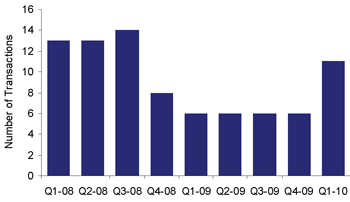
Overall, the economic conditions appear to have stabilized which has created an opportunity for companies to pursue strategic investments within the EMS sector says a report by Lincoln International.
As shown in Chart B, vertical / horizontal convergences represented seven transactions, or 64% of total activity in Q1 2010, up from three transactions in Q4 2009.
Chart B: EMS M&A by deal type, quarterly comparison
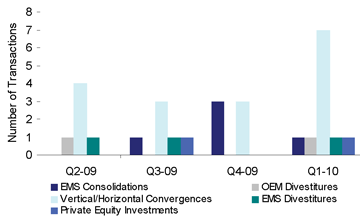
The recent trend in vertical / horizontal convergences highlights a willingness to pursue expansion opportunities as some of these transactions were EMS companies expanding well outside of their core manufacturing activities.
In addition, the trend also indicates more interest in the EMS sector with non-EMS companies purchasing EMS capabilities.
There was one EMS consolidation in Q1 2010 down from three transactions in Q4 2009. Similarly, there was one EMS divestiture in Q1 2010, up from zero transactions in Q4 2009.
There was also one transaction classified as private equity investment in Q1 2010, an increase from zero private equity investments in the previous quarter.
There was one transaction classified as an OEM divestiture in Q1 2010.
As illustrated in Chart C, three transactions occurred within Europe in Q1 2010, or 27% of total transactions, representing a sharp increase compared to zero transactions in Europe last quarter.
Chart C: EMS M&A by geography, quarterly comparison
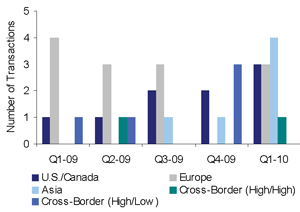
Note: “High/High” indicates cross-border transactions between Japan, Taiwan, Western Europe and U.S./ Canada; “High/Low” indicates cross-border transactions between high-cost regions and low-cost regions.
There were three U.S. / Canada deals, up from two in Q4 2009. There were four transactions within Asia, or 36% of transactions, three more than during Q4 2009 within that geography. There was one cross-border transaction for this quarter.
As shown in Chart D, transactions by size for the quarter were led by the micro tier, totaling eight, or 73% of all transactions. There were two transactions categorized as large in Q1 2010, or approximately 18% of the total. Finally, there was one transaction (approximately 9% of total transactions) in the mid tier.
Chart D: EMS Q1 2010 M&A by size
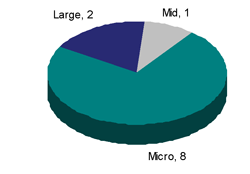
EMS Terms and turns
The cash cycle is calculated by adding days sales outstanding (DSO) and days inventory outstanding (DIO) and subtracting from this sum days payable outstanding (DPO).
The financial statistic is used to measure how quickly a company can turn sales into cash.
There are two basic disciplines in managing cash cycle: 1) contractual terms with vendors and customers, and 2) inventory turns.
Due to the fact that the electronic manufacturing services industry is very material intensive, inventory management is the most important factor in achieving cash cycle improvements.
Greater than $3 billion
In the large tier, four of the five companies cash cycles worsened (more days) while one company’s cycle shortened.
Celestica lengthened its cash cycle by 11% to 34.9 days from 31.4 in Q1-2009 due to higher DIO.
Sanmina-SCI’s cash cycle worsened from 40.2 days to 56.3 because of lower DPO and higher DIO.
Flextronics’ cash cycle shortened this year from 18.4 days to 14.3, a 22% decrease, because of higher DPO.
Elcoteq’s cash cycle increased from 7.1 days to 9.8, a 40% rise, because of lower inventory turns and higher DSO.
$300 million to $3 billion
In the Mid Tier, CTS and Sypris shortened their cash cycles while Benchmark, Plexus and Nam Tai lengthened theirs.
CTS and Sypris increased DPO, leading both companies to shorter cash cycles, while Plexus and Nam Tai both had higher DSO and DIO leading to longer cash cycles. Benchmark increased its DSO leading to a longer cash cycle as well.
$150 million to $300 million
The small tier showed improvement in cash cycles for Key Tronic, LaBarge and Sparton, while cash cycles worsened for Raven and SMTC by 11% and 10%, respectively due to higher DIO and DSO.
The cash cycles of Key Tronic, LaBarge and Sparton were shorter because of increased inventory turns.
Below $150 million
All companies in the micro tier had longer cash cycles.
The greatest increase came from IEC which lengthened its cycle 28% due to higher DSO and DIO and lower DPO. Similarly, Nortech, SigmaTron and Winland all had higher DSO, higher DIO and lower inventory turnover contributing to their lengthier cash cycles.
As indicated in Chart E, the micro tier had the highest average cash conversion cycle, and includes Sigmatron who has the longest cash cycle of all companies in the index.
Chart E: EMS contract terms (vendors customers) and inventory turns
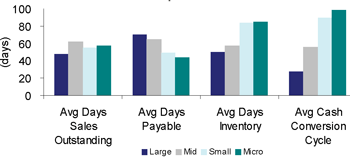
Inventory turnover
Inventory turnover is the most important cash cycle factor, making up the majority of the cycle. For example, the two companies with the longest cash cycle, SigmaTron and LaBarge with cash cycles of 139.2 and 109.4, also are among the companies that have lower inventory turns with 2.8 and 3.6, respectively.
Conversely the two companies with the shortest cash cycle, Elcoteq and Nam Tai, with cycles of 9.8 and 13.7, have the highest inventory turns of 8.6 and 17.0, respectively.
Inventory turns are also impacted by business type.
Low volume, high mix products, for which inventory management is more difficult, generally have lower turns.
The cash cycle continues to be a focus for EMS providers due to its significant impact on ROIC and the importance of cash flow for growth.
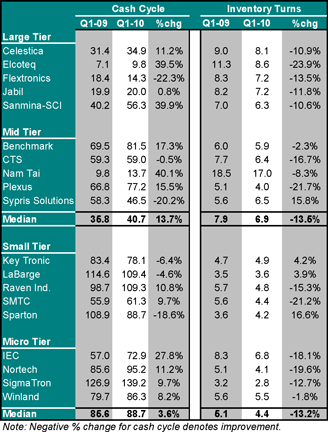
Source: Lincoln International
Get list of EMS manufacturers for your requirements (Its free)
Save time and money. Find quality EMS manufacturers. Fast. Venture Outsource has a massive, global database of contract electronic design and manufacturing capabilities. Speak with a Provider Advisor.
“Was able to very quickly find details on the important elements of setting up EMS and ODM partnerships, talked with an advisor for personalized info on quality providers matching our requirements while getting up to speed quickly about the industry and connect with key staff from like-minded companies and potential partners. Great resource.”
— Jeff Treuhaft, Sr. Vice President, Fusion-IO
Advisors tell you matches we find for your needs, answer your questions and, can share EMS industry knowledge specific to your industries and markets.






